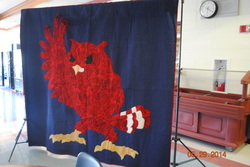Wood Working
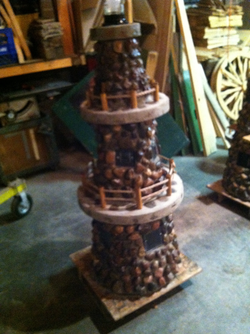
Werner Wolf (2013), St. Lawrence resident
Werner Wolf, of St. Lawrence, does wood and stone carvings of things such as lighthouses, windmills, and benches. According to his nephew, Jeff Wolf, he has been doing wood work for over 20 years and stone work for over 5 years (Wolf 2014).
-Jessica Hermann and Krischan Woehrer, Seniors, 2014
Werner Wolf, of St. Lawrence, does wood and stone carvings of things such as lighthouses, windmills, and benches. According to his nephew, Jeff Wolf, he has been doing wood work for over 20 years and stone work for over 5 years (Wolf 2014).
-Jessica Hermann and Krischan Woehrer, Seniors, 2014
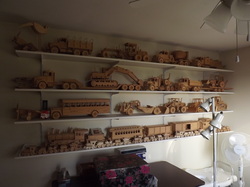
Eugene Fritz (2013), Slinger resident.
My Grandpa Fritz started woodworking after retiring from working on his farm near Allenton in 1985. He started woodworking because he was interested in it. "I saw a car in a magazine that had plans with it and I made it. It kept me out of trouble." It was never sought to be a job but a hobby. Many people were interested in his work. It came very natural to him. He began to make them and sell them or auction them off. He built any vehicle that is present today with functional parts. For instance, the tracks of an excavator moved alone with the whole arm including the bucket. He made thousands of these wooden vehicles in his life time.
-Kurtis Fritz, sophomore, Eugene's grandson
My Grandpa Fritz started woodworking after retiring from working on his farm near Allenton in 1985. He started woodworking because he was interested in it. "I saw a car in a magazine that had plans with it and I made it. It kept me out of trouble." It was never sought to be a job but a hobby. Many people were interested in his work. It came very natural to him. He began to make them and sell them or auction them off. He built any vehicle that is present today with functional parts. For instance, the tracks of an excavator moved alone with the whole arm including the bucket. He made thousands of these wooden vehicles in his life time.
-Kurtis Fritz, sophomore, Eugene's grandson
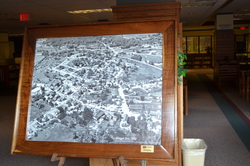
Jim Wiedmeyer (2013), Slinger resident.
Jim Wiedmeyer crafted the frame for this 1951 Slinger Aerial View photo from a felled tree in Hartford: the oldest tree in Hartford. He also made two other frames from that tree, one for a picture in the Village Hall and also one for a photo in the Gundrum Insurance building. Jim let the high school borrow the photo for the history classes to analyze as well as for the May Community Night. Here is the story from Jim.
Jim Wiedmeyer crafted the frame for this 1951 Slinger Aerial View photo from a felled tree in Hartford: the oldest tree in Hartford. He also made two other frames from that tree, one for a picture in the Village Hall and also one for a photo in the Gundrum Insurance building. Jim let the high school borrow the photo for the history classes to analyze as well as for the May Community Night. Here is the story from Jim.
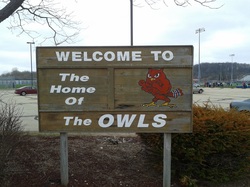
In addition, according to Jim's son, Tim, the "Welcome to the Home of the Owls" sign down by the baseball field was made by Jim. He converted a "Welcome to Slinger" sign into the sign you see today.

Incidently, Jim and Marie's late son, Brad, was quite the artist himself. While his art was not woodworking, his legacy is left in art with the following logo, which has turned into the visual symbol for the Slinger HOOPS organization and you see it on various Slinger Boys Basketball things in including apparel, magnets, and letterhead.
Fiber and Sewing (Quilting)

Students looked for evidence of fiber arts/sewing (past or present) in the Slinger Area. Students know that there is currently (2013-2014) an Allenton Quilters Club, community members in sewing guilds, a "Ties That Bind Quilt Guild" with Slinger origins that is meeting in West Bend, "It's a Stitch" in Jackson,"Sew Many Piece" (Richfield) and an historic company, June Taylor in Richfield, with origins in sewing.
Click here for a few comments about sewing by Mary Krall and Marilyn Mayer from the sewing guild.
Senior, Ciara Metzger, collaborated with Shelli Fiorenza this semester to learn how to make a t-shirt quilt that represents all the different clubs, sports, and groups that are impacting her at this point of her life. (2014)
Click here for a few comments about sewing by Mary Krall and Marilyn Mayer from the sewing guild.
Senior, Ciara Metzger, collaborated with Shelli Fiorenza this semester to learn how to make a t-shirt quilt that represents all the different clubs, sports, and groups that are impacting her at this point of her life. (2014)
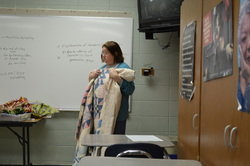
Slinger Quilter, Shelli Fiorenza, spoke to students about area quilting groups and the history of quilting in the nation and state before showing some sample quilts and helping students create a paper quilt using local culture, agents of socialization, community, groups and activities, etc. (May 2014)
Shelli, who told sociology students she's created over 2,000 quilts in her life, was asked about quilting in the Slinger area.
“The Slinger School District and Allenton too has been extremely supportive of quilting, how do I know that? Back when we did our very first quilt show as members of the ‘Slinger Area Womens Association,’ of which there was only 4 quilters in the entire group of 30. It took us a month and we had our first quilt show up and running at the Addison Town Hall. All the schools in the Slinger district allowed us to advertise for people to loan us their quilts to be used in the show. School is a great place to hear about quilting, going through the community is a great place. A lot of churches over the years have developed quilt guilds that will either quilt for their own little unique group, or they will offer their services to the community, and thats a way to get a quilt hand quilted. Otherwise it’s up to you to finish your quilt. A couple things I should explain about quilting, number one you're doing a quilt block, that is just one piece of an overall quilt.” (Transcribed by art student, Kasandra Homberg)
Shelli, who told sociology students she's created over 2,000 quilts in her life, was asked about quilting in the Slinger area.
“The Slinger School District and Allenton too has been extremely supportive of quilting, how do I know that? Back when we did our very first quilt show as members of the ‘Slinger Area Womens Association,’ of which there was only 4 quilters in the entire group of 30. It took us a month and we had our first quilt show up and running at the Addison Town Hall. All the schools in the Slinger district allowed us to advertise for people to loan us their quilts to be used in the show. School is a great place to hear about quilting, going through the community is a great place. A lot of churches over the years have developed quilt guilds that will either quilt for their own little unique group, or they will offer their services to the community, and thats a way to get a quilt hand quilted. Otherwise it’s up to you to finish your quilt. A couple things I should explain about quilting, number one you're doing a quilt block, that is just one piece of an overall quilt.” (Transcribed by art student, Kasandra Homberg)
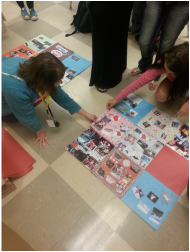
Shelli (left) showing students options for placing individual designs into patterns on a quilt. Students pondered themes and colors. Her advice was to try different locations, take a photo, and evaluate different options before making a choice permanent. Shelli thanked students for their creativity, patience, and open-mindedness. (Photo by student, Lainey Russell, May 12th 2014)
Click here for the description of the project and observation notes from the second day of the workshop by senior student, Marek Bartusek. Marek observed design norms and values within the two sociology classes.
Click here for the description of the project and observation notes from the second day of the workshop by senior student, Marek Bartusek. Marek observed design norms and values within the two sociology classes.
